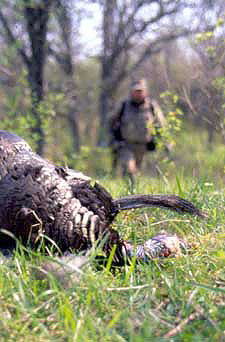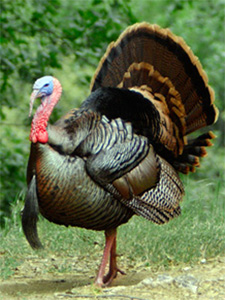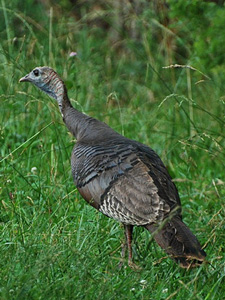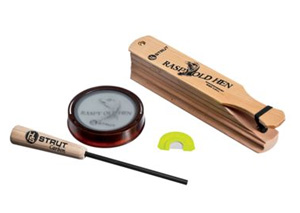
 Any hunter who has ever heard the thunderous gobble of a nearby male turkey knows why turkey hunting is one of the most exciting pursuits that a sportsman can undertake. However, to the newcomer, the special seasons, along with the specialized gear and tactics, can also be intimidating.
Any hunter who has ever heard the thunderous gobble of a nearby male turkey knows why turkey hunting is one of the most exciting pursuits that a sportsman can undertake. However, to the newcomer, the special seasons, along with the specialized gear and tactics, can also be intimidating.
Everything you need to know to get started in this thrilling sport will be covered in this two-part series. Part one will cover the rules and tactics, and Part two will discuss the gear and safety.
Rules for Hunting Turkey
Turkeys are hunted in 49 States and three Canadian Provinces. All of these jurisdictions have at least a spring hunt, and many also have a fall turkey season. The spring season is much more popular with hunters, due in part to the fact that most of these locales have few other hunting opportunities in the spring; whitetail deer, small game, and waterfowl seasons are just a few of the other options that compete for the attention of hunters in the fall. As a result, much of the fall turkey harvest is merely incidental to pursuing other species while also carrying a turkey tag.
During the spring hunt, only mature male turkeys, known as toms, or juvenile males, known as jakes, may be harvested. Most jurisdictions allow the harvest of both males and females during their fall hunts.
Telling males and females apart is not difficult. Male turkeys, often called gobblers, are a darker brown color — even bordering on black — than the females. Gobblers' heads are a combination of red and blue, while their feathers have a metallic sheen. Females, known as hens, are generally a drab brown from head to toe.
Gobblers are also larger than hens. While most hens won't weigh more than 12 or 14 pounds, big gobblers can grow to twice that size.
The most telling difference between males and females, however, is the bristly tuft of modified feather that resembles hair that males grow on their chests, known as a beard. Only bearded birds are legal during the spring season. While a jake's beard is usually very short and stubby, a mature tom's beard can be as long as 12 inches or more. Although the length of the beard is irrelevant from a legal perspective, the length of a tom's beard, along with the sheer size of the bird, is the measure of a bird's trophy status.
Some of the spring seasons restrict daily hunting hours to dawn to noon, or dawn to mid-afternoon. This is to minimize disturbance to nesting hens, which nest on the ground. During the fall hunts, however, hunting is generally allowed from dawn to dusk. The other big difference in the rules governing the different hunting seasons is in the type of firearms that can be used. Generally only shotguns or bows are allowed during the spring, while rifles or handguns are also allowed during the fall in some places.
As always, make sure to consult state or provincial hunting regulations for seasons, limits and other local rules.
Turkey Hunting Tactics
Spring is the breeding season for the wild turkey, and it's a good thing too — if not for the fact that male turkeys are somewhat preoccupied at this time of year, hunters would have a very hard time bagging these wily birds.
 |
 |
| Male turkeys (left) are larger and darker than female turkeys (right). | |
In the spring, tom turkeys will gather and breed with as many hens as they can. In their quest to add additional hens to their harems, gobblers will respond by gobbling to a hunter imitating the call of a hen. By continuing to call to an interested gobbler, the hunter hopes to lure the amorous bird into range.
The classic strategy for bagging a gobbler in the spring is to actually locate a bird the night before. Turkeys roost in trees overnight, and by scouting a likely area during the late afternoon or early evening before a hunt, a hunter can locate a gobbler either visually or by getting him to respond to a number of different turkey calls. Either way, the bird is likely to roost for the night in a nearby tree and, unless disturbed from his roost during the night, will still be there the next morning.
Well before first light the next morning, the hunter will quietly sneak to within a couple hundred yards of the roosted gobbler and find a nice wide tree to sit up against. By calling to the gobbler right away, even before he flies down from his roost just before dawn, a hunter is often able to lure the gobbler in before he becomes occupied with real hens or feeding.
Because the gobbler has love on his mind, the most common calls to imitate during the spring are those of the hen turkey, with the yelp being the key call. These calls will usually get a gobbler to respond by gobbling back, and hopefully get him into shooting range. But this doesn't always work because the courtship of real hens and gobblers works the opposite way, with the tom calling the hens to him. If a wary gobbler decides to play hard-to-get and refuses to be lured in by your best hen calls, imitating a gobbler rather than a hen can sometimes take advantage of the jealous streak in the tom. By making gobbling sounds, the hunter hopes to make the gobbler think that another gobbler is trying to move in on the hen.
Fall hunting can be a bit different. As previously mentioned, hunters who are mainly hunting deer, bears, or other game take many of the turkeys harvested each fall. However, for those who wish to target turkeys in the fall, it is important to realize that it is completely different from hunting turkeys in the spring. As the birds are not breeding at this time of year, the hunter must use different tactics to lure a bird into shooting range. Rather than using a big tom's jealousy against him, hunters instead depend on the gregarious nature of turkeys.
 |
| Turkey call strategies in the spring are different than those in the spring. |
Autumn birds are either grouped into large flocks of adult males or a mixture of immature males and females. The most common approach to turkey hunting in the fall is to locate a flock of turkeys and then try to break the flock apart. This is done by sneaking up as close to the flock as possible and then rushing at the birds (with gun unloaded) until they run or fly away, hopefully each in a different direction.
A dog can also be used instead to accomplish the same thing (if legal in your state). Once this is done, the hunter finds a good place to hide right in the middle of where the birds were, and starts to call. The idea is that the birds want to get back together into a flock and will soon start to call to locate each other and regroup.
The calls to make in the fall are also different from the spring calls. The hunter is merely trying to imitate the sound of a hen turkey that is trying to locate other birds from its flock. The most common calls to imitate in the fall are the adult hen assembly "yelp," the juvenile hen "kee-kee," or in the case of mature toms, coarse gobbler "yelps."
To learn about the basics of turkey hunting gear and some safety rules to get you started in turkey hunting, please read the Turkey Hunting Tips: Hunting Rules and Tactics Part 2.
- 54725 views

